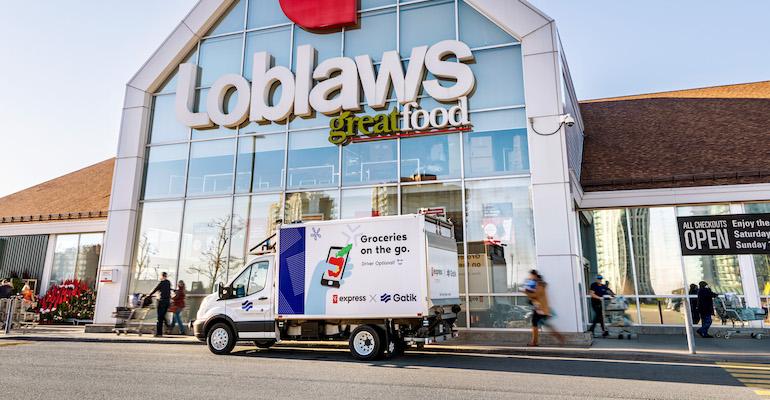Gains in both the food and drug channels lifted retail sales for Loblaw Cos. in its fiscal 2021 second quarter, and per-share earnings exceeded analysts’ forecast.
Loblaw said Wednesday that retail sales in the 12-week quarter ended June 19 totaled $12.28 billion (Canadian), up 4.4% from $11.77 billion a year earlier.
Food retail sales edged up 1.5% to $8.88 billion from $8.75 billion a year ago, though same-store sales were virtually flat, down 0.1%. The comparable-store dip followed a 10% gain in the fiscal 2020 quarter, which was fueled by pandemic-driven consumer demand, Loblaw noted, adding that its two-year food retail sales compound annual growth rate (CAGR) was 6.3%. Basket size was down and traffic was up on a comparable basis for the quarter.
 “Food retail same-store sales were flat in the quarter. The market declined slightly against same-store sales growth of 19% last year, while discount same-store sales were positive,” Loblaw Chief Financial Officer Richard Dufresne (left) told analysts in a conference call on Wednesday.
“Food retail same-store sales were flat in the quarter. The market declined slightly against same-store sales growth of 19% last year, while discount same-store sales were positive,” Loblaw Chief Financial Officer Richard Dufresne (left) told analysts in a conference call on Wednesday.
“Our average article price was up 1.4% for the quarter and declined from 3.9% in Q1. The increase in average article price compared to last year was mainly driven by sales mix. Loblaw’s CPI comparable inflation rate was less than 1% in the first half of 2021,” said Dufresne, who also is president and CFO of George Weston Ltd., Loblaw’s parent company. “Traffic improved in Q2, recording growth for the first time since the beginning of the pandemic. On a two-year rate, food same-store sales reflected average growth of 5.6%.”
Drug retail sales, from Loblaw’s Shoppers Drug Mart chain, came in at $3.4 billion, up 12.7% from $3.02 billion in the prior-year period. Sales rose by 5.3% to $1.75 billion in the front end and by 21.7% to $1.66 billion in the pharmacy. Comparable pharmacy sales surged by 9.6%, including gains of 3.6% in the front end and 17.2% in the pharmacy.
Prescription count grew 1.9% overall and inched up 0.3% on a comp-store basis, Loblaw reported. Average prescription value increased 18.3%, following an 11.2% decrease a year earlier.
“Front-store sales saw some momentum from cosmetics and OTC categories as [pandemic] restrictions loosened, recording strong growth compared to last year,” Dufresne said. “Pharmacy performance was strong, lapping volatility of day supply restriction in the prior year. On a two-year average rate, drug same-store sales have grown 5.7%, with front store at 4.6% and Rx at 6.9%.”
E-commerce sales dipped in the second quarter after a 133% year-over-year jump in the 2021 first quarter and a big gain in the 2020 second quarter.
“Our online business continued to operate at penetration levels well above pre-COVID rates. After record growth of 280% in Q2 last year, sales declined 0.5% versus Q2 of last year,” Dufresne said in the call. “That said, online sales increased in the mid-single digits versus Q1. We remain focused on driving customer metrics and delivered sequential improvements in both customer-facing metrics and profitability.”
For the 24-week fiscal 2021 first half, retail sales totaled $23.95 billion, up 2.6% versus a year ago. Food retail sales advanced 1.6% to $17.36 billion, with same-store sales flat. Shoppers Drug Mart’s first-half sales totaled nearly $6.6 billion, a gain of 5.1%. Comp-store sales rose 3.8%, including an increase of 10% in the pharmacy and a decrease of 1.4% in the front of the store.
 “Our grocery divisions performed well in the first part of the [second] quarter, aided by COVID restrictions that kept Canadians eating at home during the spring and early summer. This translated into strong market share demonstrating the underlying health of our business. As communities across the country began opening up, we were particularly pleased with the re-emergence of value-seeking shopping trips, which was good for our discount formats,” Loblaw Chairman and President Galen Weston (left) told analysts during the call.
“Our grocery divisions performed well in the first part of the [second] quarter, aided by COVID restrictions that kept Canadians eating at home during the spring and early summer. This translated into strong market share demonstrating the underlying health of our business. As communities across the country began opening up, we were particularly pleased with the re-emergence of value-seeking shopping trips, which was good for our discount formats,” Loblaw Chairman and President Galen Weston (left) told analysts during the call.
“Our drugstore business was also impacted by the pandemic,” he said. “Spring cough-and-cold season was virtually nonexistent due to the mask usage and social distancing. On the other hand, allergy season was particularly robust, as people rushed outside at the first hint of spring. And we’re seeing customers return to our beauty counters as communities open up.”
At the bottom line, fiscal 2021 second-quarter net income (available to common shareholders) came in at $375 million, or $1.09 per diluted share, compared with $688 million, or $1.99 per diluted share, in the prior-year period, when pandemic-driven demand hoisted profits, Loblaw reported. Adjusted net earnings for common shareholders totaled $464 million, or $1.35 per diluted share, versus $856 million, or $2.48 per diluted share, a year earlier.
Analysts, on average, had projected adjusted earnings per share of $1.17, with estimates ranging from $1.07 to $1.36, according to Refinitiv.
“As we look forward, the good news of an increasingly vaccinated nation and a far less restricted life for Canadians will change our business yet again, and it is difficult to predict exactly what the magnitude of those impacts will be,” said Weston, who also serves as chairman and CEO of George Weston Ltd. “We expect our Shoppers [Drug Mart] business to grow stronger as some of its most important categories, like beauty and pharmacy, return to a more normal run rate. We expect our e-commerce business to shift from headwind to tailwind. And we expect a return of value-focused shopping to deliver a relative benefit for our discount format. However, we also know that our entire business will face top-line pressure as we lap the elevated sales from COVID.”
Loblaw said it opened 20 nine food and drug stores and closed nine. As of the second quarter’s end, the company’s retail network encompassed 2,442 stores, including 548 corporate-owned supermarkets under multiple banners, 548 franchised grocery stores and 1,346 Shoppers Drug Mart/Pharmaprix associate-owned drugstores.


